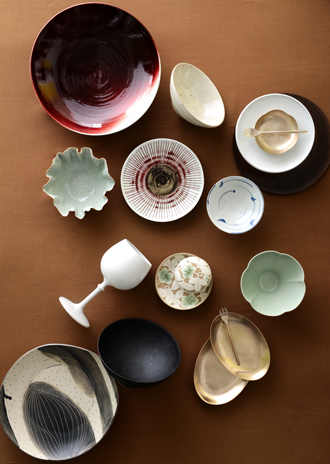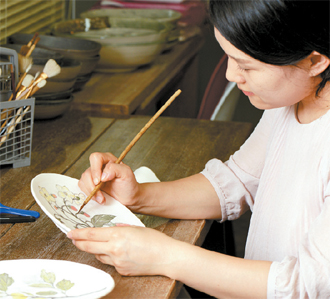Korean pottery finding a place at dinner tables

Although all these products are from different potters and brands, they are all characteristically Korean. [JoongAng Ilbo]
Now she realizes that Korean food doesn’t go well with the plates and bowls of foreign brands, which usually come in bold patterns and prints.
Since most Korean food - from red kimchi to green vegetables - are visually strong and vivid, Korean chinaware is considered the best serving option by people who should know: chefs.
“Dishes that make food look beautiful and appetizing are the best containers,” says chef Kim Gwang-sun, who published a book titled “Chef’s Tableware.”
In addition to its simple, natural beauty, pottery can be highly functional. These containers, made with clay, are natural insulators that keep food warm or cool.
Not only chefs, but Japanese visitors are also developing a renewed interest in and appreciation for Korean pottery.
Japanese, who hold bowls close to their mouths when eating rice and noodles, think highly of the texture and design of pottery tableware, according to Ido Gallery, located in Samcheong-dong, central Seoul.
“Much of our income comes from Japanese travelers,” says Jung Won-jung, who does public relations for Ido Gallery, which displays works by Yi Yoon-shin.
Having a collection of beautiful, useful tableware is a housewife’s dream. In recent years, northern European brands like Royal Copenhagen, Arabia Finland, Rorstrand and Gustavsberg have been catching on in Korea.
While these brands remain popular, an increasing number of Koreans are paying attention to often underestimated Korean pottery that comes in a variety of contemporary shapes and colors.
Kim recommends Urigurut Ryu in Sinsa-dong, southern Seoul, as an ideal place to check out the latest trends in domestic pottery.
Urigurut Ryu is roughly translated as “Ryu the Dishware of Our Own.” Food expert Kim Ju-young, who teaches catering at Casa School, mentioned Ido Gallery and Kwangjuyo.

Potter Choi Ju-hee runs No. 38 Workshop at Sindang Creative Arcade, in Hwanghak-dong, Jung District, central Seoul. Some Koreans design and order tableware of their own from small workshops. [JoongAng Ilbo]
Some people go further than just buying Korean pottery: They make their own. Potter Choi Ju-hee runs No. 38 Workshop at Sindang Creative Arcade in Hwanghak-dong, Jung District, central Seoul, where she makes custom pottery.
“You can decide the dimensions of the plate, color and even small details,” says Choi. “In addition to that, if you order in bulk, the price per piece goes down.”
Majoring in pottery, Choi graduated from Hongik University and was working on her own projects until her older brother asked her to produce custom tableware for a restaurant where he was in charge of interior design.
The results received rave reviews and changed Choi’s primary job.
When designing and ordering tableware, Choi says, the first thing one should do is think about the overall style, design, color, size and number of items needed.
After an initial consultation, a sample is made in advance for review before Choi begins production. It takes about three weeks on average for customers to receive the end products.
Do it yourself
There are other workshops where you could make your own tableware. One in Hoegi-dong, northern Seoul, is Kkumirum Workshop, which offers beginning and intermediate courses.
The beginning course covers how to make basics, including plates and bowls. The intermediate course teaches how to make accessories and more sophisticated everyday items.
One-day classes are also available. For 22,000 won ($19), aspiring potters can make a snowman-shaped food tray for toddlers. If there are more than 10 people who wish to learn how to make pottery, an instructor will go to a home or other location to show them how. For more information, visit http://reem.co.kr/.
Surejil Workshop in Buk District, Gwangju, South Jeolla, is run by Ra Pil-ju. Customers can order tableware in baekja (white porcelain), cheongja (celadon), onggi (earthenware) and many other styles.
Ra said it takes about a month to complete most orders and the price is about the same as for ready-made Korean pottery brands. For more information, visit http://cafe.naver.com/surejil.
No matter how beautifully bowls and plates are made, they should be well-matched for the type of food for which they will be used.
For stews and soup, the best container is a ttukbaegi, or earthen pot, which is capable of absorbing and releasing air. It also withstands heat well.
Gomtang or oxtail soup goes well with brassware bowls, because the vessel keeps broth warm for a long period of time.
By Han Da-hye [so@joongang.co.kr]










with the Korea JoongAng Daily
To write comments, please log in to one of the accounts.
Standards Board Policy (0/250자)